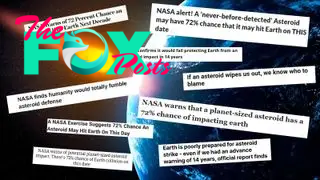Science
No, NASA hasn't warned of an impending asteroid strike in 2038. Here's what really happened.

Officials from NASA and other international organizations recently completed a mock test to assess their ability to respond to a hypothetical asteroid potentially crashing into Earth in 2038.
The tabletop exercise went as planned and has largely been deemed a success by those involved. However, several media outlets have misreported what happened, either making it seem like the impact scenario was real or that we are worryingly ill-equipped to deal with it — neither of which is true.
Between April 2 and April 3, nearly 100 experts from more than 25 organizations in the U.S. and abroad — including NASA's Planetary Defense Coordination Office, the Federal Emergency Management Agency (FEMA) and the Department of State's Office of Space Affairs — met at the Johns Hopkins Applied Physics Laboratory in Laurel, Maryland, to participate in the Planetary Defense Interagency Tabletop Exercise.
This event, which involved team members informally discussing potential responses to a hypothetical asteroid strike, was the fifth and largest version of its kind, following similar meetings in 2013, 2014, 2016 and 2022, Live Science's sister site Space.com reported.
"A large asteroid impact is potentially the only natural disaster humanity has the Technology to predict years in advance and take action to prevent," Lindley Johnson, the lead program executive for NASA's Planetary Defense Coordination Office, said in a statement about the event. Simulating such a scenario can help give experts experience in dealing with such situations and highlight knowledge gaps in current protocols that need to be addressed in the future, he added.
Related: 'Planet killer' asteroids are hiding in the sun's glare. Can we stop them in time?

On June 20, leading members of the exercise team shared and discussed the results of the latest simulation in an online news conference. During this event, they also revealed the hypothetical scenario used in this year's exercise to the public for the first time.
-

 Science3d ago
Science3d agoInside Capitol Hill’s Latest UFO Hearings
-

 Science3d ago
Science3d agoYou Won’t Want to Miss the Leonid Meteor Shower. Here’s How and When You Can See It
-

 Science4d ago
Science4d agoHere’s What Trump’s Win Means for NASA
-

 Science1w ago
Science1w agoWhy Risky Wildfire Zones Have Been Increasing Around the World
-

 Science1w ago
Science1w agoIt’s Time to Redefine What a Megafire Is in the Climate Change Era
-

 Science1w ago
Science1w ago4 Astronauts Return to Earth After Being Delayed by Boeing’s Capsule Trouble and Hurricane Milton
-

 Science1w ago
Science1w agoThe Elegance and Awkwardness of NASA’s New Moon Suit, Designed by Axiom and Prada
-

 Science2w ago
Science2w agoSpaceX Launches Its Mega Starship Rocket. This Time, Mechanical Arms Catch It at Landing



























